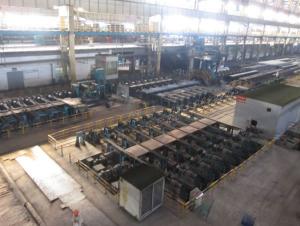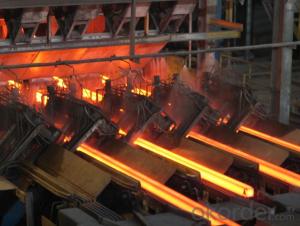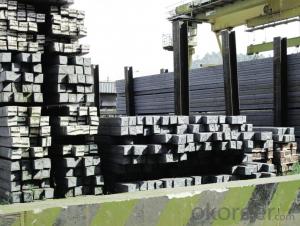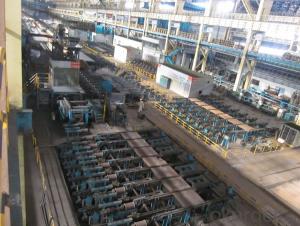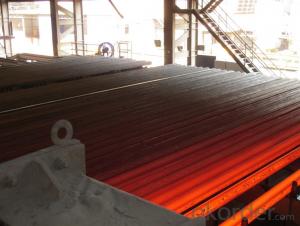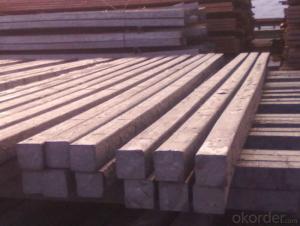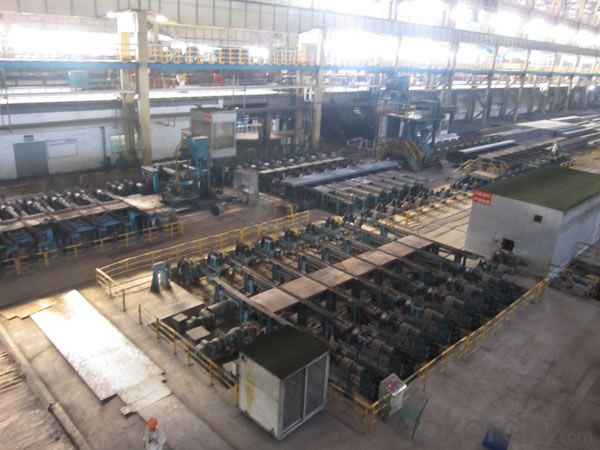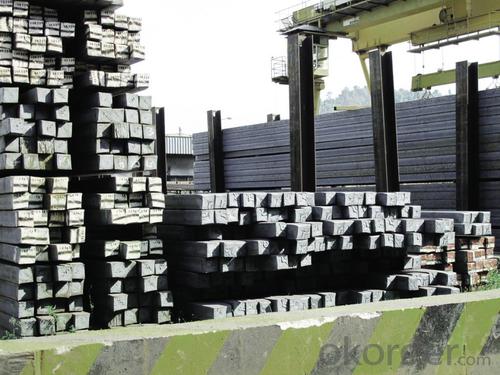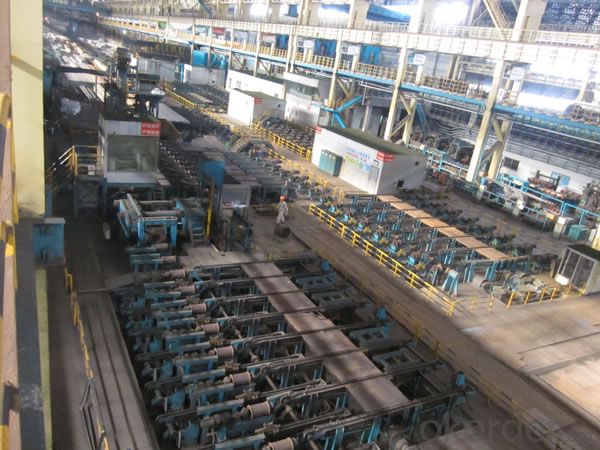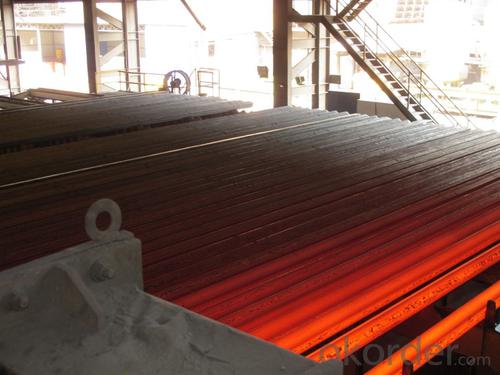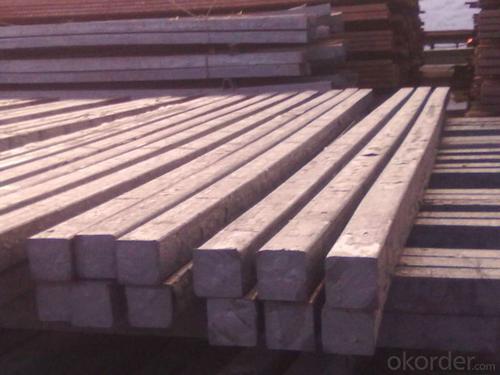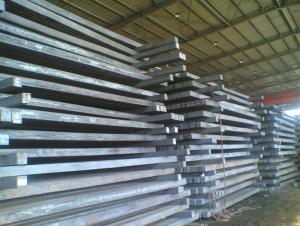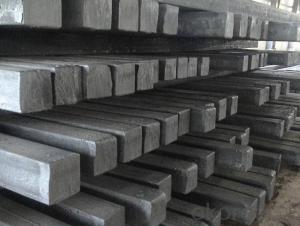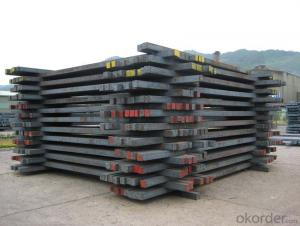Hot Rolled Square Steel Billet 3SP Standard 90mm
- Loading Port:
- Shanghai
- Payment Terms:
- TT OR LC
- Min Order Qty:
- 2000 m.t.
- Supply Capability:
- 10000 m.t./month
OKorder Service Pledge
OKorder Financial Service
You Might Also Like
Structure of Hot Rolled Square Steel Billet 3SP Standard 90mm
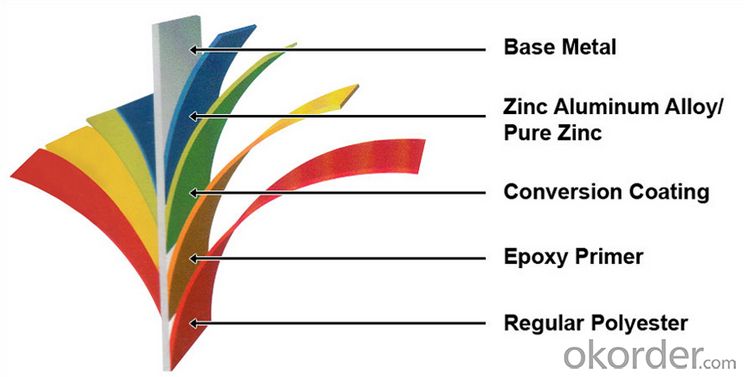
Description of Hot Rolled Square Steel Billet 3SP Standard 85mm
PPGI is made by cold rolled steel sheet and galvanized steel sheets as baseplate, through the surface pretreatment (degreasing, cleaning, chemical conversion processing), coated by the method of continuous coatings (roller coating method),
and after roasting and cooling. Zinc coating: Z60, Z80, Z100, Z120, Z180, Z275, G30, G60, G90
Alu-zinc coating: AZ60, AZ80, AZ100, AZ120, AZ180, G30, G60, G90
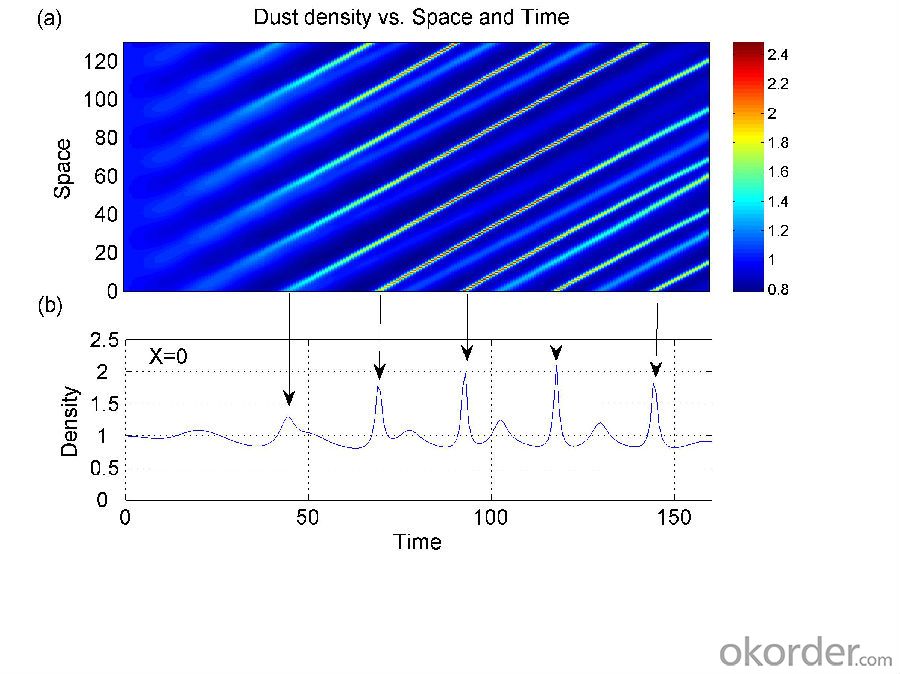
Main Feature of Hot Rolled Square Steel Billet 3SP Standard 90mm
1) Excellent corrosion resistance: The zinc layer provides a good protection of Pre-painted Galvanizeed Steel Sheet.
2) High heat resistance: The reflective surface of the material aids in efficiently reflecting the sunlight away and in turn reducing the amount of heat transmitted. The thermal reflectivity converts into energy savings.
3) Aesthetics: Pre-Painted Galvanized steel sheet is available in plethora of patterns and multiple sizes as per the requirements that given by our customers.
4) Versatility: can be used in the various areas.Standard seaworthy export packing: 3 layers of packing, inside is kraft paper, water plastic film is in the middle and outside GI steel sheet to be covered by steel strips with lock, with inner coil sleeve.
Applications of Hot Rolled Square Steel Billet 3SP Standard 90mm
1) Automotive bodies: filters, fuel tanks, etc.
2) Construction materials: roofings, welding pipes,
3) Electric and electronic appliances: computer cans, etc.
4) Steel cans: containers, etc.
5) Steel furniture: washing machines, refrigerators, microwaves, etc.
6) Drums
7) Office equipment: printer, recorders, etc.
8) Motors and transformers
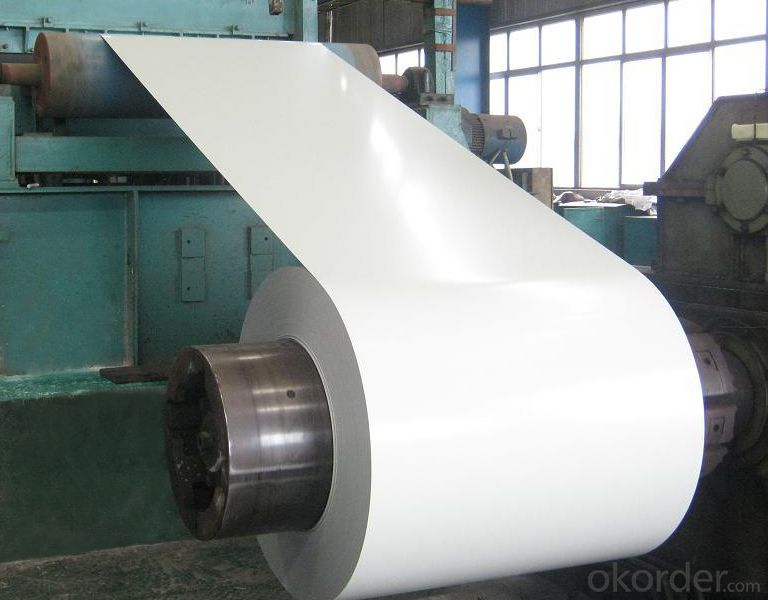
Specifications of Hot Rolled Square Steel Billet 3SP Standard 90mm
| Classified symbol | Yield Point Minimum N/mm2 | Tensile Strength Minimum | Elongation Minimum % | Application | ||||
| N/mm2 | Nominal Thickness mm (t) | |||||||
| JIS | Yogic | 0.25-0.4 | 0.4-0.6 | 0.6-1.0 | 1.0-1.6 | |||
| G3312 | specification | |||||||
| CGCC | CGCC | -205 | -270 | -20 | -21 | -24 | -24 | Commercial |
| CGCD | CGCD | --- | 270 | --- | 27 | 31 | 32 | Drawing |
| --- | CG340 | 245 | 340 | 20 | 20 | 20 | 20 | Structural |
| CGC400 | CG400 | 295 | 400 | 16 | 17 | 18 | 18 | Structural |
| CGC440 | CG440 | 335 | 440 | 14 | 15 | 16 | 18 | Structural |
| CGC490 | CG490 | 365 | 490 | 12 | 13 | 14 | 16 | Structural |
| CGC570 | CG570 | 560 | 570 | --- | --- | --- | --- | Structural |
| ASTM Designation | Yield Point Minimum | Tensile Strength Minimum | Elongation Minimum % | Application | Q/BQB 445-2004(China standard) | ASM A653/A653M | JISG 3312 | |
| ksi(MPa) | ksi(MPa) | TDC51D+Z | (CS TYPE A+Z) | CGCC | ||||
| A653(M)-99 CS TYPE A,B,C | --- | --- | --- | Commercial | TDC52D+Z | CGCD | ||
| A653(M)-99 FS | --- | --- | --- | Lock Forming | TS250GD+Z | (G250+Z) | - | |
| A653(M)-99 DS | --- | --- | --- | Drawing | TS300GS+Z | (G300+Z) | CGC 400 | |
| A653(M)-99 SS Grade33(230) | 33(230) | 45(310) | 20 | Structural | TS350GD+Z | (G350+Z) | CGC490 | |
| A653(M)-99 SS Grade37(255) | 37(255) | 52(360) | 18 | Structural | TS550GD+Z | (G550+Z) | CGC570 | |
| A653(M)-99 SS Grade40(275) | 40(275) | 55(380) | 16 | Structural | ||||
| A653(M)-99 SS Grade50(345) | 50(345) | 65(450) | 12 | Structural | ||||
| A653(M)-99 SS Grade80(550) | 80(550) | 82(570) | --- | Structural | ||||
FAQ of Hot Rolled Square Steel Billet 3SP Standard 90mm
We have organized several common questions for our clients,may help you sincerely:
1. How Can I Visit There?
Our company is located in Tianjin City, China, near Beijing. You can fly to Tianjin Airport Directly. All our clients, from home or aboard, are warmly welcome to visit us!
2. How Can I Get Some Sample?
We are honored to offer you sample.
3. Why choose CNBM?
1, ISO, BV, CE, SGS approved.
2, Competitive price and quality.
3, Efficient service team online for 24 hours.
4, Smooth production ability(50000tons/month) .
5, quick delivery and standard exporting package.
6, Flexible payment with T/T, L/C, Paypal, Kunlun bank, etc .
- Q: What are the potential applications of steel billets in the packaging industry?
- Steel billets can be used in the packaging industry for various applications such as manufacturing metal cans, containers, and closures. They provide strength, durability, and resistance to external factors like pressure, impact, and corrosion. Additionally, steel billets can be molded into different shapes and sizes, making them suitable for diverse packaging requirements.
- Q: How are steel billets used in the production of construction parts?
- Steel billets are used in the production of construction parts as they serve as the raw material for various manufacturing processes. These billets are heated and then shaped into different forms such as beams, columns, and rods through processes like rolling and forging. The resulting construction parts are strong, durable, and capable of withstanding the structural demands of buildings and infrastructure projects.
- Q: What types of steel are commonly used for billets?
- There are several types of steel that are commonly used for billets, depending on the specific application and desired properties. One common type is carbon steel, which is an alloy of iron and carbon. Carbon steel billets are widely used because of their high strength, durability, and affordability. They are suitable for a variety of applications, including construction, automotive, and machinery industries. Another type of steel used for billets is alloy steel. Alloy steel billets are made by adding various alloying elements such as chromium, nickel, and molybdenum to carbon steel. These alloying elements enhance the strength, toughness, and corrosion resistance of the steel, making it suitable for more demanding applications like aerospace, oil and gas, and power generation. Stainless steel is also commonly used for billets, especially in applications where corrosion resistance is critical, such as in marine environments or food processing industries. Stainless steel billets are made by adding chromium and sometimes other elements like nickel or molybdenum to carbon steel. This combination of elements provides excellent resistance to corrosion, high temperatures, and chemicals. Finally, tool steel is another type of steel used for billets, primarily in the manufacturing of tools and dies. Tool steel billets are made with specific alloying elements like tungsten, vanadium, or cobalt, which give them exceptional hardness, wear resistance, and heat resistance properties. These billets are essential for producing precision tools and components used in industries such as automotive, aerospace, and manufacturing. In summary, the types of steel commonly used for billets include carbon steel, alloy steel, stainless steel, and tool steel. The choice of steel depends on the specific application requirements, such as strength, corrosion resistance, or hardness.
- Q: What are the main factors affecting the dimensional tolerances of steel billets?
- The main factors affecting the dimensional tolerances of steel billets include the quality of the raw material used, the manufacturing process employed, and the precision of the equipment and tools used during production. Additionally, environmental conditions such as temperature and humidity can also impact the dimensional tolerances of steel billets.
- Q: What is the role of steel billets in the production of railway wagons?
- Steel billets play a critical role in the production of railway wagons as they serve as the raw material for manufacturing various components, such as the wagon body, chassis, and structural elements. These billets are heated and shaped into desired forms through processes like rolling and forging, which enable the creation of strong and durable wagon parts. By providing the necessary strength and structural integrity, steel billets contribute to the overall safety, reliability, and longevity of railway wagons, ensuring they can withstand the demanding conditions and heavy loads encountered during their service on the railways.
- Q: What are the main differences between hot-rolled and cold-rolled steel billets?
- The main differences between hot-rolled and cold-rolled steel billets lie in the manufacturing process and the resulting characteristics of the steel. Hot-rolled steel billets are produced at high temperatures, resulting in a rougher surface and less precise dimensions. They are more malleable and ductile, making them suitable for applications that require shaping or bending. On the other hand, cold-rolled steel billets are manufactured at room temperature, resulting in a smoother and more precise surface finish with tighter dimensional tolerances. Cold-rolled steel billets are stronger and exhibit better surface hardness, making them ideal for applications that require strength, precision, and a superior surface finish.
- Q: What are the different types of steel billet quality control tests?
- There are several different types of steel billet quality control tests that are conducted to ensure the integrity and suitability of the billets for further processing. These tests are essential in detecting any defects or inconsistencies in the billets, and they help to maintain the desired quality standards in the steel industry. Some of the common types of steel billet quality control tests include: 1. Visual Inspection: This test involves a visual examination of the billets to identify any surface defects such as cracks, seams, or dents. It is the most basic form of quality control and can be performed quickly. 2. Dimensional Inspection: In this test, the dimensions of the billets are measured and compared against the specified tolerances. This ensures that the billets are within the required size range and meet the dimensional requirements for subsequent processing. 3. Chemical Composition Analysis: This test involves analyzing the chemical composition of the steel billets to ensure that they meet the specified chemical requirements. It includes determining the percentages of various elements such as carbon, manganese, sulfur, and phosphorus. 4. Mechanical Testing: This test is performed to evaluate the mechanical properties of the steel billets, such as tensile strength, yield strength, and elongation. These properties are crucial in determining the suitability of the billets for specific applications. 5. Ultrasonic Testing: This non-destructive testing method uses ultrasonic waves to detect internal defects in the billets, such as cracks or voids. It is particularly useful in identifying hidden defects that may not be visible during visual inspection. 6. Magnetic Particle Inspection: This test involves applying a magnetic field to the billets and then applying magnetic particles to the surface. Any surface or near-surface defects will cause the particles to gather, indicating the presence of a defect. 7. Eddy Current Testing: This method uses electromagnetic induction to detect surface defects or variations in the billets' electrical conductivity. It is effective in identifying cracks, voids, or inconsistencies in the billets' microstructure. 8. Microstructure Analysis: This test involves examining the microstructure of the steel billets under a microscope to assess their homogeneity, grain size, and presence of any undesirable phases. It helps in determining the overall quality and suitability of the billets for further processing. These tests, along with various other specific tests, form an integral part of steel billet quality control. By conducting these tests, manufacturers can ensure that the billets meet the required standards and possess the necessary properties for their intended applications.
- Q: Can steel billets be used in the production of mining equipment?
- Yes, steel billets can be used in the production of mining equipment. Steel billets are semi-finished products that are commonly used in the manufacturing industry to produce various types of steel products, including mining equipment. The high strength and durability of steel make it an ideal material for mining equipment, which often operates in harsh and demanding environments. Steel billets can be processed and shaped into different components such as gears, shafts, frames, and buckets, which are essential parts of mining equipment. Additionally, steel billets can be easily welded, machined, and heat-treated to meet the specific requirements and standards of mining equipment. Therefore, steel billets play a crucial role in the production of mining equipment by providing the necessary strength and reliability needed for safe and efficient mining operations.
- Q: What are the different types of steel billet welding processes?
- There are several different types of steel billet welding processes that are commonly used in various industries. These processes include: 1. Shielded Metal Arc Welding (SMAW): Also known as stick welding, SMAW involves a flux-coated electrode that is manually fed into the welding pool. It is a versatile and widely used process for welding steel billets. 2. Gas Metal Arc Welding (GMAW): This process, commonly known as MIG welding, uses a continuously fed wire electrode and a shielding gas to protect the weld pool. It is a popular method for welding steel billets due to its efficiency and ease of use. 3. Flux-Cored Arc Welding (FCAW): FCAW is similar to GMAW, but it uses a tubular electrode filled with flux instead of a solid wire. This process is often preferred for outdoor or windy conditions as the flux provides better protection against atmospheric contamination. 4. Submerged Arc Welding (SAW): SAW involves feeding a consumable electrode and a granular flux into the weld zone, while the arc remains submerged beneath a layer of flux. It is commonly used for welding large steel billets due to its high deposition rates and deep penetration capabilities. 5. Gas Tungsten Arc Welding (GTAW): Also known as TIG welding, GTAW uses a non-consumable tungsten electrode and a shielding gas to protect the weld pool. It is a precise and high-quality welding process suitable for thin steel billets or applications that require exceptional weld aesthetics. 6. Electroslag Welding (ESW): ESW is a highly efficient process used for welding thick steel billets. It involves melting a consumable electrode and the base metal in a molten slag pool, which provides protection and acts as a filler material. 7. Laser Beam Welding (LBW): LBW utilizes a high-energy laser beam to melt and join steel billets together. It is a precise and fast welding process commonly used in industries such as automotive and aerospace. Each of these welding processes has its own advantages and limitations, and the choice of process depends on factors such as the type and thickness of the steel billet, desired weld quality, production requirements, and cost considerations.
- Q: What are the different surface defects that can occur in steel billets?
- Some of the different surface defects that can occur in steel billets include cracks, scales, pitting, scratches, and surface irregularities.
Send your message to us
Hot Rolled Square Steel Billet 3SP Standard 90mm
- Loading Port:
- Shanghai
- Payment Terms:
- TT OR LC
- Min Order Qty:
- 2000 m.t.
- Supply Capability:
- 10000 m.t./month
OKorder Service Pledge
OKorder Financial Service
Similar products
Hot products
Hot Searches
Related keywords
